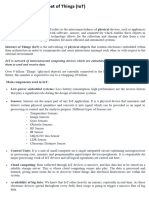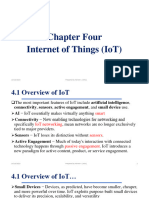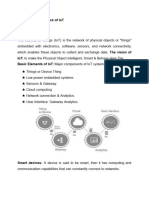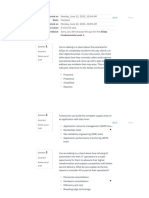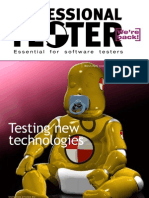29-07-2023
Module 1
Essentials of Internet of Things
Topics Covered (Module 1)
• IoT Emergence
• Definition and Characteristics of IoT
• IoT product development life cycle
1
� 29-07-2023
What is IoT? & Emergence
Definition: It is a network of physical objects like
devices, vehicles, buildings and other things embedded
with electronics, software, sensors and network
connectivity which enables these objects to collect and
exchange data.
The scope of IoT is not limited to just connecting
things (device, appliances, machines) to the Internet.
IoT allows these things to communicate and exchange
data (control & information).
Processing on these data will provide us various
applications towards a common user or machine goal.
IoT Analytics forecasts the IoT market size to grow at a
CAGR of 22.0% to $525 billion from 2022 until 2027
How IoT works?
2
� 29-07-2023
weblink
• https://www.tutorialspoint.com/what-are-the-characteristics-of-
internet-of-things-iot
• https://aws.amazon.com/what-is/iot/
• https://www.geeksforgeeks.org/characteristics-of-internet-of-things/
Characteristics of IoT
1. Connectivity
Anything, anywhere, any time, should be connected to the
infrastructure
Connectivity is the ability to communicate with and share
information between two or more devices
Connectivity enables these objects to be controlled remotely, and
also allows them to exchange data with other objects
Connectivity is possible using wired LAN or wireless technologies
like Wi-Fi, LPWAN, LoRa, ZigBee, etc
3
� 29-07-2023
2. Identity of Things
• Each IoT device should have IP address
• This helpful to tracking the device and time to query its
status
3. Scalability
Scalability represents ability of a system to grow without affecting its performance of the system
The number of elements connected to the IoT zone is increasing day by day
IoT setup should be capable of handling the massive expansion
4. Architecture
• IoT architecture should be heterogeneous
• Devices in IoT different hardware platform, uses different
network and different algorithm
• Ability to support diverse technologies, protocols, and devices
• Devices do not interfere with each other
5. Security
• IoT devices are vulnerable for cyber attack , chance of data
leakage and chance of personal data being transferred without
approval
• IoT security tools should protect from threats and breaches, identify
and monitor risks and can help fix vulnerabilities.
• IoT security ensures the availability, integrity, and confidentiality of your
IoT solution
4
� 29-07-2023
6. Dynamic or Self-Adapting
IoT devices should dynamically adapt themselves to the changing contexts and
scenarios
Assume a camera meant for the surveillance. It should be adaptable to work in
different conditions and different light situations (morning, afternoon, night).
7. Self Configuring
IoT devices are able to upgrade their software in accordance with requirements with a minimum of user
participation.
Additionally, they can set up the network, allowing for the addition of new devices to an already-
existing network.
IoT product development life cycle
Data Manufacturing &
Design Review Prototyping Validation
collection Maintenance
Data collection
Problem statement
Understanding the needs and demands of the product
Review marketing research, similar products, user needs, timeline, and team to prepare a
feasibility report to provide direction
Technical strategy for product development - Complete document about functional
components , power, product size etc..
Identify the funding sources
5
� 29-07-2023
8. Intelligence
• IoT smart sensor generate huge amount of data
• Extraction of knowledge from generated data is
important
• This data should be interpreted properly
Design
Identify the tool for prototype design
Circuit design and software development for prototype
design
Generally using off-the-shelf hardware and software
Identify the connectivity solution for your IoT product,
range, battery lifetime, and product cost
6
� 29-07-2023
Review
Once the most appropriate circuit design and software
components is formulated, the developers must continuously
make necessary changes.
It is possible by reviewing the circuit design and functionality
throughout the project.
Schematics, layouts, software algorithms and mechanical aspects of
the product
Continuously make necessary changes to meet the highest performance and
cost efficiency
Prototyping
• Circuit design implementation is carried out in this
stage
• Integration of software and hardware
• Test the various components, such as sensors,
simulators, embedded boards, modules, etc.
• Minimizing the error at the end of prototyping is the
main aim of this step
• Evaluate the cost/performance ratio and form factor
required by the customer
7
� 29-07-2023
Validation
Testing and validating the final prototype
Testing the hardware component under different
condition parameters, such as amplitude, magnitude,
voltage, power consumption, temperature, etc.
Once validated, the product is all set to be
manufactured.
Manufacturing and Maintenance
Prototype is forwarded to the manufacturer
The manufacturing step involves the assembly of the various
components of the circuit design and gives life to the initial
idea
Deployment of product
Maintenance from time to time to stay in touch with
technological developments.
Upgrading it to newer versions from time to time.
8
� 29-07-2023
https://www.tutorialspoint.com/what-is-the-internet-of-things-iot-
lifecycle#:~:text=Testing%20and%20validating%20the%20final,all%20set%20to%20be%20manufactured.
https://www.softwaretestinghelp.com/iot-devices/
https://www.tutorialspoint.com/what-is-the-internet-of-things-iot-lifecycle
IoT enabling Technologies
9
� 29-07-2023
Wireless Sensor Network(WSN)
WSN comprises distributed devices with sensors which are
used to monitor the environmental and physical conditions
WSN consists of end nodes, routers and coordinators
End nodes have several sensors attached to them where the
data is passed to a coordinator with the help of routers
The coordinator also acts as the gateway that connects WSN to
the internet
Application:
Weather monitoring system
Indoor air quality monitoring system
Soil moisture monitoring system
Health monitoring system
10
� 29-07-2023
Cloud computing
• Cloud computing is the on-demand
availability of computer system resources
• computing, networking and storage
resources
• Metered services to the users
• Cloud Computing resources can be
accessed over the network using standard
access mechanisms that provide platform
independent access through use of
heterogeneous client platforms such as
workstations laptops tablets and
Smartphones.
Three different services
PaaS (Platform as a service)
SaaS (Software as a service)
IaaS (Infrastructure as a service)
11
� 29-07-2023
Big Data Analytics :
Big Data analytics is the process of collecting, organizing and analyzing large sets
of data (called Big Data) to discover patterns and other useful information.
Big Data analytics can help organizations to better understand the information
contained within the data and will also help identify the data that is most
important to the business and future business decisions.
The data analytics framework consists of six steps namely: collection, cleaning,
integration, analysis, visualization and alerting.
Examples of big data generated by IoT systems:
•Sensor data generated by IoT system such as weather monitoring stations.
•Machine sensor data collected from sensors embedded in industrial and energy
systems for monitoring their health and detecting Failures.
•Health and fitness data generated by IoT devices such as wearable fitness bands
•Data generated by IoT systems for location and tracking of vehicles
•Data generated by retail inventory monitoring systems
Communication protocols
• Backbone of IoT systems
• communication protocols help in sending and
receiving data onto and into the device
• Protocols are also used for implementing control
flow mechanisms, routing mechanisms, sequence
control mechanisms, etc data encryptions, data
compression, and hardware configurations
• Communication technologies such as non-cellular
(Zigbee, Wi-Fi, LoRaWAN, Radio frequency
identification) and cellular networks (2G, 3G, 4G,
5G, LTE, NB-IoT) can be the key for such sensor
networks to connect and transmit data.
12
� 29-07-2023
Embedded Systems
• It is a combination of hardware and software
used to perform special tasks.
• It includes microcontroller and microprocessor
memory, networking units (Ethernet Wi-Fi
adapters), input output units (display keyword
etc. ) and storage devices (flash memory).
• It collects the data and sends it to the internet.
• Embedded systems are able to perform only
certain activities. It uses limited hardware
and software aids as far as any embedded
system’s design is concerned.
IoT applications
13
� 29-07-2023
Smart Home and Office
Smart Door access control system IoT devices measure electricity and water usage daily by the
Smart lighting for home and office established sensors in the meter.
14
� 29-07-2023
Wearable Devices
Wearable technology is the hallmark of IoT applications and one of the earliest industries to
deploy IoT.
fit bits, heart rate monitors and smartwatches these days.
Guardian glucose monitoring device has been developed to help people with diabetes.
It detects glucose levels in our body, uses a small electrode called the glucose sensor under
the skin, and relates it to a radiofrequency monitoring device.
Agriculture
•Sensors are used to provide details of soil chemistry and
fertilizer profiles. CO2 levels, moisture, temperature, level of
acidity, and the presence of appropriate nutrients all contribute
to how good a harvest turns out to be.
•Smart irrigation is an IoT application to regulate and
efficiently use water for farming. The IoT system only initiates
the water flow when the soil reaches a certain dryness level. It
also stops the supply once a certain level of moisture is reached.
This reduces wastage caused by human errors.
•Livestock tracking involves the use of RFID chips to keep track
of an animal’s vitals, vaccination details, and location.
•A smart greenhouse uses microclimate to raise crops instead
of relying on changing weather patterns. Sensors monitor and
control all parameters and have automated systems for light and
water.
15
� 29-07-2023
Healthcare
Doctors can monitor patients’ status remotely and suggest necessary
procedures when required.
IoT enabled health care devices help measure blood pressure, and
an oximeter regulates our body temperature
surgical robots that can help doctors in performing surgeries more
efficiently with higher precision and control
•Parking solutions:
Smart parking solutions provide drivers with
real-time information about empty spaces
available.
•Traffic management:
•Sensors on roads and traffic signals send data to the IoT systems.
This data, accumulated over time, allows officials to analyze traffic
patterns and peak hours. It also helps create solutions for
bottlenecks.
•Commuters can use this information to determine which areas are
congested and what alternate routes can be used. A version of this
already exists in third-party map services such as Google Maps.
Smart Pollution Control
• collecting the data related to city pollution like emissions from
vehicles, pollen levels, airflow direction, weather, traffic levels,
etc using various sensors in combination with IoT
• Machine Learning algorithms can calculate pollution forecasts in
different areas of the city
• Inform the concerned authority and the government well in
advance to take steps to control pollution.
16
� 29-07-2023
Disaster management Energy Saving
Different types of sensors are being equipped in the
devices to save electric and water energy.
It prevents useless waste by establishing a dual
communication system between the energy power user
and the supplier.
These devices also help in monitoring energy
consumption regularly.
17











































